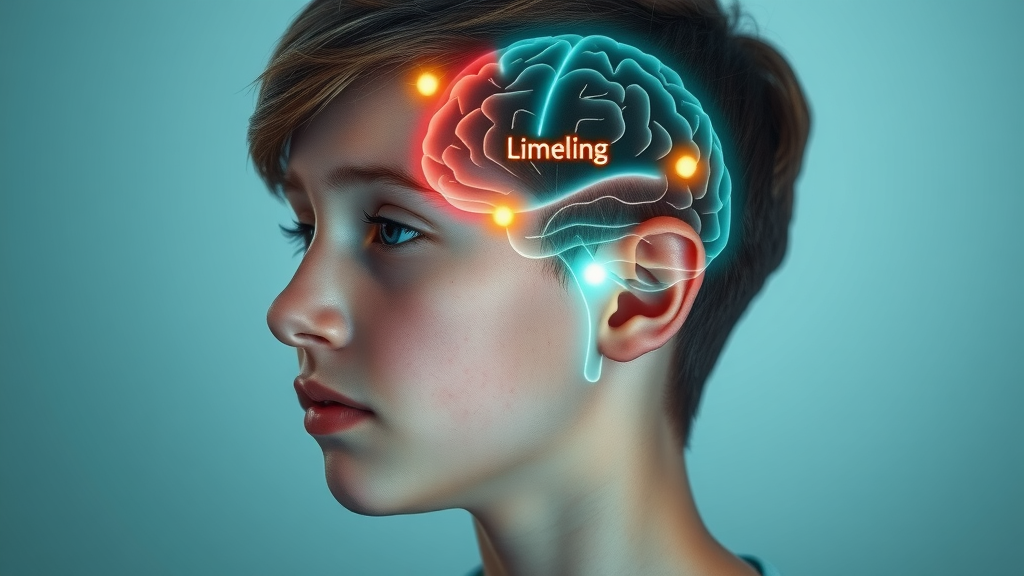Did you know that a teenager’s brain isn’t fully mature until the mid-20s, with impulse control and decision-making skills developing long after adolescence? This unconventional fact underpins why young people often display behaviors that puzzle even the most patient adults. Unraveling the science behind adolescent brain development offers fresh insights into why teens act the way they do—and how parents, educators, and caregivers can best support them through these formative years.
Unveiling the Adolescent Brain Development: A Statistical Perspective
The journey of adolescent brain development is backed by fascinating research. According to brain scans from official government and university websites, the human brain undergoes more changes during adolescence than at almost any other time in life, rivaled only by the changes in early childhood. Some studies reveal that the volume of gray matter—the brain area responsible for processing and cognition—reaches its peak in early adolescence, followed by a process of pruning that makes the teen brain more efficient. Meanwhile, white matter, which connects brain regions for better communication, continues to increase, enhancing how young people process information. The implication: the teen brain isn't just an immature version of the adult brain—it's a dynamic, evolving organ that works uniquely, rewiring itself as it adapts to new experiences and challenges. This landscape explains why the behavior of a typical adolescent can be bold, unpredictable, and highly influenced by their surroundings.
Statistics highlight that nearly 90% of brain growth occurs by age 6, but the regions of the brain involved in executive function—such as the prefrontal cortex—continue to refine themselves all the way through early adulthood. In fact, many cognitive and affective skills that define adulthood are still under construction during the teen years. These findings support the growing recognition that adolescent brain development is both a period of opportunity and vulnerability, setting the stage for lifelong habits and well-being.
Startling Facts: How the Adolescent Brain Develops Differently
During the teenage years, the brain is remarkably plastic, or capable of change. Unlike the adult brain, which has already established most neural pathways, the adolescent brain is actively pruning unused connections and strengthening those that are frequently used. This means experiences during adolescence have an outsized impact compared to other life stages. For example, risk-taking and impulsivity—often baffling to adults—are connected to an imbalance in the pace of development between the limbic system (the brain area responsible for emotions and rewards) and the prefrontal cortex (responsible for self-control and planning).
This mismatch means the typical adolescent is primed for learning, especially through novel and emotionally charged experiences. However, it also explains why teens are more susceptible to peer influence and risk-related behaviors. Innovations in brain scanning technology allow scientists to identify these developmental processes with unprecedented detail, making the teenage brain one of the most interesting, yet challenging, subjects in neuroscience.

What You'll Learn About Adolescent Brain Development
- The scientific phases of adolescent brain development
- Key differences between the teen brain and adult brain
- Influences of brain structure on adolescent behavior
- The role of mental health during brain development
- Answers to pressing People Also Ask questions
The Science Behind Adolescent Brain Development
Adolescent brain development is a complex process involving significant growth, refinement, and reorganization of brain areas. The journey begins just before puberty, with surges of hormones kickstarting changes in both brain structure and function. Unlike the steady progression seen in childhood, adolescence brings a wave of neural development that affects everything from cognitive and affective abilities to social behaviors.
The process is underpinned by two simultaneous events: synaptic pruning and myelination. Synaptic pruning fine-tunes brain networks by eliminating unnecessary neural connections—a process that makes the brain more efficient and responsive but can also increase vulnerability to stress and mental health issues. Myelination, on the other hand, insulates connections between brain cells, speeding up information processing. These changes help explain why adolescents become more capable of complex thought but may still struggle with self-regulation, especially under pressure or in emotionally charged situations.
Critical Stages of Brain Development in Young People
There are three main stages in adolescent brain development: early adolescence, middle adolescence, and late adolescence. Each stage is marked by specific cognitive and emotional changes. In early adolescence (typically ages 10-13), the brain's gray matter increases rapidly, particularly in areas of the brain that regulate sensation and movement. At the same time, young people begin to show a greater interest in peer relationships and independence, with the brain's reward system becoming more active.
In middle adolescence (ages 14-17), the regions of the brain involved in reasoning and impulse control are busy catching up to earlier changes in the limbic system. This gap can make teens more prone to risk-taking and emotional swings, especially as the prefrontal cortex continues to mature. By late adolescence (ages 18-25), these processes start to stabilize. Decision-making, planning, and self-control improve, marking the shift toward adult patterns of thinking and behavior. Understanding these stages helps parents and educators tailor their support to each young person's unique needs.
Key Brain Structures Involved in Adolescent Brain Development
Several critical brain structures are at the forefront of adolescent brain development. The most prominent are the prefrontal cortex, which governs executive functions like decision-making and impulse control, and the limbic system, which processes emotions and rewards. During adolescence, these areas develop at different speeds. The limbic system matures earlier, making young people more sensitive to rewards and emotional experiences, while the prefrontal cortex lags behind, leaving impulse control and reasoning under construction.
Other important structures include the corpus callosum, which connects the brain's two hemispheres, and the cerebellum, which refines motor skills and coordination. Recent research using advanced brain scanning (such as fMRI) reveals that ongoing changes in gray matter and white matter during adolescence contribute to the unique learning and behavioral patterns seen in this age group. These evolving brain structures underpin the intense creativity, social awareness, and adaptability often observed in the typical adolescent.
"The typical adolescent brain is a masterpiece in progress—brighter, bolder, and more adaptive than at any other life stage."
How the Teen Brain Differs: Comparing the Adolescent and Adult Brain
The differences between the adolescent brain and the adult brain are striking. While the adult brain is shaped by established neural networks, the teen brain is defined by ongoing growth and reorganization. This developmental distinction is most evident in impulse control, risk-taking, and emotional regulation—areas still evolving in adolescents but stable in adults. These differences are not just theoretical but are substantiated by neurological studies comparing specific brain areas in teens and adults.
For example, the prefrontal cortex is the last brain area to fully develop, contributing to challenges with long-term planning and self-awareness in the teen years. Meanwhile, the connectivity between the limbic system and prefrontal cortex is still forming, making adolescents more reactive to emotional cues and peer influence than their adult counterparts. Knowing these differences can help parents, educators, and even young people themselves appreciate why behavior shifts so dramatically during adolescence.
| Aspect | Teen Brain | Adult Brain |
|---|---|---|
| Impulse Control | Developing | Mature |
| Risk-Taking | High | Lower |
| Emotional Regulation | In Progress | Established |
| Brain Structure | Dynamic Connectivity | Stabilized Networks |
| Pruning & Growth | Ongoing | Minimal |
Influence of Brain Structure on Adolescent Behavior
Adolescent behavior is not random—it's shaped by the intricacies of a developing brain structure. As the brain undergoes synaptic pruning and myelination, young people experience fluctuating motivation, mood swings, and evolving social priorities. Researchers have found that exposure to positive experiences during this period can optimize brain development, while chronic stress or negative environments may hinder growth.
The link between brain areas and behavior is particularly evident in decision-making, emotional regulation, and risk-taking. Teens’ brains prioritize immediate rewards and social acceptance, which influences their choices—often in ways that challenge adult expectations. Understanding these connections is paramount for anyone seeking to support healthy development in adolescents.

Prefrontal Cortex: Decision-Making and Risk Assessment
The prefrontal cortex stands out as the central hub for executive functions in the adolescent brain. This region orchestrates planning, risk assessment, impulse control, and rational thinking. However, in teens and young people, this area is still under significant development. As a result, adolescents might make impulsive decisions, have difficulty anticipating future consequences, or struggle with regulating their immediate reactions to challenges.
Scientists using brain scans have observed that the slower maturation of the prefrontal cortex can make teens more susceptible to peer pressure, as their executive control systems aren't fully online. On the upside, this period of flexibility allows for rapid learning and adaptation, setting the stage for complex cognitive and social skills. For parents and caregivers, understanding the limitations and potential of this evolving brain area invites empathy and more effective communication with young people.
Emotional Centers: Limbic System and Typical Adolescent Responses
The limbic system is the primary emotional center in the adolescent brain, comprising key brain areas like the amygdala and hippocampus. This region matures ahead of the prefrontal cortex, making emotional responses especially powerful for teens. The heightened sensitivity of the limbic system to rewards and social dynamics can drive risk-taking, novelty seeking, and strong attachments to peers.
It's critical to recognize that the typical adolescent's emotional outbursts or mood swings are neither intentional nor within full conscious control. Rather, these behaviors are a consequence of the developmental timeline of different brain structures. As neural connections between the limbic system and prefrontal cortex strengthen, teens gain greater mastery over their emotions—but until then, patience, guidance, and supportive environments are essential.
Mental Health and Adolescent Brain Development
Mental health is a crucial aspect of adolescent brain development, as this period involves both heightened vulnerability and potential. The ongoing changes in gray matter and neural connectivity can exacerbate tendencies toward anxiety, depression, or other mental health issues. Conversely, a nurturing environment and early interventions can lay a foundation for lifelong emotional resilience.
During adolescence, young people encounter new stressors from academic, family, and social pressures. Recognizing and addressing these challenges early can prevent them from escalating into chronic conditions. Support strategies may include fostering open communication, providing access to mental health resources, and promoting healthy lifestyle habits like sleep and physical activity.
Impact of Stress and Environment on Young People
Environmental influences—such as family stability, school climate, peer relationships, and societal pressures—leave deep imprints on the developing brain. Chronic stress or exposure to adversity can trigger changes in the brain’s reward system and emotional centers, making young people more prone to risk-taking or withdrawal. Studies show that negative experiences during adolescence are linked to long-term impacts on mental health and brain structure, including alterations in gray matter.
On the flip side, supportive relationships and positive social environments can buffer stress and promote healthy brain development. Encouragement, connection, and access to guidance help young people navigate the emotional ups and downs of adolescence. School settings that prioritize mental health and family environments where teens feel safe expressing themselves are especially protective. These findings highlight the vital role caregivers and educators play in adolescent well-being.

Early Signs of Mental Health Issues in the Developing Brain
Detecting mental health concerns during adolescent brain development can be challenging, as symptoms may blend with normal developmental changes like moodiness or withdrawal. Early signs include persistent sadness, sudden academic decline, changes in sleep or eating patterns, and social isolation. Other warning signals can involve drastic shifts in behavior, irritability, or loss of interest in activities that used to bring joy.
Being aware of these indicators is essential for early intervention, which has been shown to significantly improve outcomes. Parents, educators, and health professionals should approach young people with empathy and openness, encouraging honest conversations about feelings and experiences. Early support doesn’t just address current challenges—it can strengthen the brain’s resilience and set up young individuals for long-term emotional health.
"Understanding adolescent brain development can transform the way we approach mental health for young people."
External Factors Affecting Brain Development in Adolescents
The developing adolescent brain is highly responsive to external influences. Family dynamics, school environments, community context, and technology all shape the brain’s structure and function during these formative years. Research indicates that positive experiences—such as supportive relationships, access to education, and opportunities for healthy risk-taking—can optimize brain development, while chronic stress or negative influences may lead to setbacks.
Environmental factors like nutrition, sleep, access to mental health resources, and engagement in extracurricular activities contribute to building resilience in young people. Conversely, exposure to trauma or ongoing adversity can increase vulnerability to mental health issues and impact cognitive performance. Recognizing the importance of these external variables is crucial for anyone working with children and teens.
The Influence of Family, School, and Society
Family approaches to communication, discipline, and emotional support leave lasting marks on adolescent brain development. Studies show that teens from stable, nurturing families exhibit healthier emotional regulation and better academic performance, while those exposed to adversity may face increased risk of behavioral and mental health issues. School environments also matter: positive relationships with teachers, engaging curriculum, and a safe, inclusive atmosphere can encourage brain growth and improve social skills.
Broader societal influences—including media representation, cultural expectations, and access to community resources—shape the experiences of young people as well. Collectively, these factors either nurture or challenge the developing brain, influencing outcomes that extend well into adulthood. Providing consistent support across family, school, and society is paramount for healthy adolescent growth.
Technology Use and Its Effects on the Teen Brain
Digital technology is a defining feature of the modern adolescent experience. While technology can offer educational benefits and avenues for social connection, heavy or unregulated screen use poses risks to mental focus, sleep patterns, and emotional regulation. Brain scans have shown that excessive technology exposure may overstimulate the brain’s reward system, making it harder for young people to find motivation in offline activities.
Setting healthy boundaries around technology use—such as device-free meals, designated downtime, and mindful content choices—can protect the developing brain from negative effects. Encouraging young people to balance screen time with real-world social interactions, physical activity, and creative pursuits maximizes the potential benefits of technology while minimizing its downsides.

Timeline: How the Adolescent Brain Develops Over Time
The timeline of adolescent brain development can be divided into three clear phases, each with distinct characteristics and implications for behavior and learning. These stages provide a roadmap for understanding the challenges and opportunities facing young people on the path to adulthood.
Early adolescence (ages 10-13) is characterized by rapid growth and synaptic pruning, setting the foundation for social awareness and cognitive flexibility. Middle adolescence (ages 14-17) brings heightened risk-taking, sensitivity to peer influence, and emotional fluctuation. Finally, late adolescence (ages 18-25) is a time of brain maturation, improved decision-making, and greater independence. This developmental arc is universal but influenced by individual experiences, environment, and genetics.

- Early adolescence (10-13 yrs): Rapid growth and pruning
- Middle adolescence (14-17 yrs): Increased risk-taking, emotional fluctuation
- Late adolescence (18-25 yrs): Maturation, decision-making refinement
People Also Ask About Adolescent Brain Development
At what age is your brain the sharpest?
Researchers believe that the brain is sharpest for different skills at different ages. Cognitive processing speed peaks in the late teens and early twenties; however, emotional intelligence, vocabulary, and complex reasoning can continue to improve well into the thirties and forties. For most young people, adolescence and early adulthood are periods of rapid attention, learning, and memory formation. This is largely due to the dynamic brain development occurring during these years, making these decades ideal for acquiring new skills and building cognitive resilience that can benefit a person throughout life.
What are major characteristics of adolescent brain development?
The major characteristics of adolescent brain development include synaptic pruning (removing redundant neural connections), increased myelination (insulating brain pathways for faster communication), and an imbalance in the maturity of the limbic system and prefrontal cortex. This results in high risk-taking, sensitivity to peer feedback, and heightened emotionality in the typical adolescent. As the brain's structure continues to evolve, so do the cognitive and affective functions associated with decision making, impulse control, and social interaction. Understanding these traits helps adults recognize the driving forces behind many teen behaviors.

At what age does the adolescent brain stop developing?
The adolescent brain continues to develop into the mid-twenties for most individuals. Key areas such as the prefrontal cortex—responsible for executive functions and self-regulation—are among the last to fully mature. While some brain regions reach near-adult levels by the late teens, organizing, planning, and judgment skills don't typically fully develop until between ages 22 and 25. This extended period of brain development underscores the importance of continued support, positive environments, and healthy routines for young adults navigating early independence.
At what age is 95% of the brain developed?
Approximately 95% of the brain’s physical size is reached by age 6, but the structure of the brain and the connections within it remain under active construction through adolescence and into early adulthood. While the majority of growth in gray matter and white matter occurs during infancy and early childhood, synaptic pruning and process refinement continue across the teen years. This means that although the brain appears nearly fully grown, its most important wiring and specialization is still underway throughout the second decade of life and beyond.
Supporting Healthy Adolescent Brain Development: Tips for Young People and Caregivers
- Prioritize quality sleep and nutrition
- Encourage open communication and emotional awareness
- Engage in challenging cognitive tasks
- Foster healthy social environments
- Monitor technology use and set boundaries
Supporting the developing brain is a group effort that involves practical strategies and nurturing environments. Consistent routines, emotional support, and encouragement for trying new things can strengthen both cognitive and affective abilities in adolescents. When caregivers understand the unique needs of the adolescent brain, they can adapt their approach to discipline, nurturing independence and resilience while maintaining important boundaries and support.
FAQs on Adolescent Brain Development
-
How does sleep affect brain development in adolescents?
Sleep is critical for adolescent brain development. During sleep, the brain consolidates learning, repairs itself, and strengthens neural connections. Teens who get adequate, quality sleep tend to show better emotional regulation, memory, and academic performance, while persistent sleep deprivation can exacerbate mood swings, risk-taking, and attention issues. -
Can adolescent brain development be accelerated or slowed down?
While genetics play a key role, environmental factors like chronic stress, poor nutrition, and inadequate sleep can slow brain development. Conversely, supportive environments, cognitive challenges, and proper care can encourage optimal growth, though there are natural developmental limits that cannot be artificially accelerated beyond biological timelines. -
What are common misconceptions about the teen brain?
A common misconception is that teens make irrational decisions simply out of rebellion or carelessness. In reality, ongoing brain development explains much of this behavior. The mismatch of limbic system and prefrontal cortex maturity causes natural impulsivity, emotional reactivity, and an openness to learning from new experiences. -
Is adolescent brain development the same for everyone?
No—adolescent brain development is influenced by genetics, environment, experiences, nutrition, and health. Some young people mature earlier or later than peers. While the general timeline is consistent, individual variability should always be expected and respected.
Key Takeaways: What Every Parent and Educator Should Know About Adolescent Brain Development
- Brain development continues into the mid-twenties
- Adolescent behavior often reflects ongoing neural changes
- Mental health support is critical during this stage
- Positive environments foster better outcomes
Summing Up Adolescent Brain Development and Next Steps
The adolescent brain is a work in progress—a time of remarkable growth, challenge, and opportunity. Supporting young people with knowledge, empathy, and science-backed strategies ensures the most positive outcomes on their journey to adulthood.
 Add Row
Add Row  Add
Add 





Write A Comment